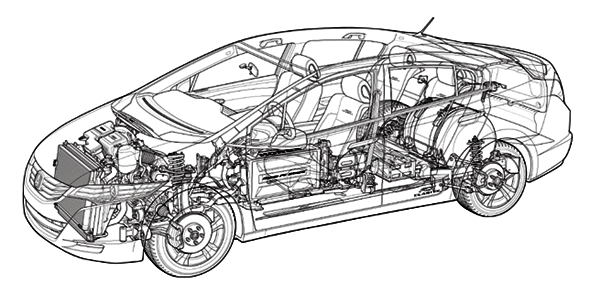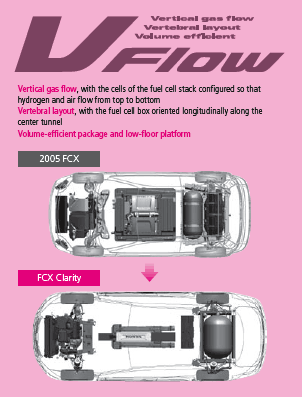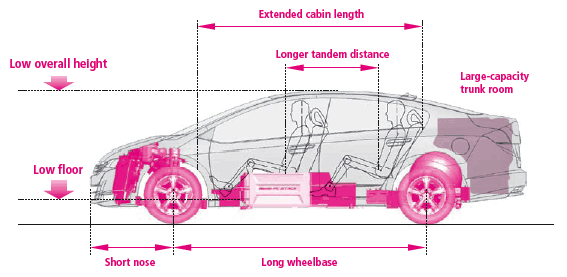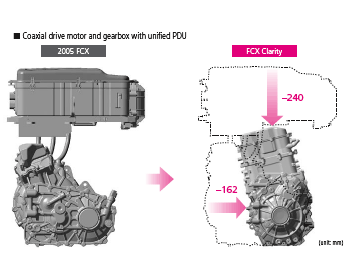Layout
Human-friendly packaging: the future of comfort.
Distributing the powerplant redefines the basic configuration of the automobile.

The new V Flow FC platform allows for unprecedented spaciousness. It's the next generation in human-friendly design.

The most distinctive feature of the fuel cell vehicle - other than the fuel cell itself - is the layout flexibility made possible by the fact that the powerplant and drive train can be distributed throughout the vehicle. In order to take full advantage of this feature, each component in the powerplant must be made extremely compact. To this end, each part of the fuel cell stack - the drive motor and gearbox, the power drive unit, the lithium ion battery, and even the hydrogen tank and radiators - have been made as compact and as high-performance as possible. This creates maximum freedom to optimize the position of each part to achieve the spacious, full-cabin design unique to this new fuel cell vehicle. The end product is the embodiment of Honda's man maximum, machine minimum design philosophy - and the next generation in human-friendly automobiles.

 The V Flow FC Stack is located inside the center tunnel, and the lithium ion battery is placed under the rear seat. The result is a free-flowing, full-cabin design with a long wheelbase that provides the spacious and comfortable seating that customers expect in a luxury car.
The V Flow FC Stack is located inside the center tunnel, and the lithium ion battery is placed under the rear seat. The result is a free-flowing, full-cabin design with a long wheelbase that provides the spacious and comfortable seating that customers expect in a luxury car.
The drive motor, gearbox and PDU are combined for major space savings in the drive train system. A more compact radiator unit contributes to the short-nose design.
Reducing the number of parts in the hydrogen tank and modifying its shape result in a more efficient use of space, creating ample room in the rear seating and trunk areas. Improvements both to the hydrogen tank and the FC stack layout result in a low floor and low overall height - the car's packaging is sporty and functional.

Powertrain
The technology - a powerplant that is sure to spark a revolution in design, packaging and performance
In addition to making the fuel cell stack, drive motor, and other individual components more compact, parts have been consolidated into modular units. The result is an amazingly compact and lightweight design - 397 pounds (180 kg) lighter and 45% smaller than the previous powerplant.
A significantly more compact, unified fuel cell system
The fuel cell stack is now contained in one box instead of two. This reduces the number of parts required to connect the stacks together and allows the hydrogen supply system, humidifier system, and contactors to be combined into a single unit that is 65% smaller than the previous system. This makes it possible to locate the stack in the vehicle's center tunnel rather than under the floor, achieving a low-floor, low-height body design.

 Unified coaxial drive motor/gearbox and PDU
Unified coaxial drive motor/gearbox and PDU
An innovative configuration, with drive motor and gearbox oriented coaxially, achieves a 162 mm reduction in length as measured along the drive axis. This coaxial motor/gearbox is further combined with the Power Drive Unit (PDU) in a unified configuration that saves another 240 mm in height. These innovations make possible the FCX Clarity's stylish, short-nose design.
Compact, high-efficiency lithium-ion battery requires less space
The vehicle's auxiliary power source, the new lithium-ion battery, delivers improved performance and energy recovery in a more lightweight, compact package. The new battery is 40% lighter and 50% smaller than the ultra-capacitor of the 2005 FCX, allowing it to be stowed under the rear seat. This gives the car more passenger space and a bigger trunk.

Integration of functions in hydrogen tank
Whereas the 2005 FCX carries two hydrogen tanks, the FCX Clarity has only one. This creates more space for the rear seats and trunk. The shut-off valve, regulator, pressure sensor, and other components in the refueling and supply system were integrated into a single in-tank module, reducing the number of parts by 74%. Tank capacity is greater, installation space efficiency is 24% better, and vehicle range is increased.

Three radiators integrated into one
Increased powerplant efficiency, vehicle weight reduction, and improved aerodynamics have resulted in a major reduction in heat generation. The cooling air vent for the motor bay has been reconfigured and the cooling capacity of the radiators increased. These improvements made it possible to integrate the fuel cell radiator, the drive train radiator, and the air conditioning condensor into a single three-layer unit. The new radiator unit requires 40% less space, contributing to the stylish short-nose design.
